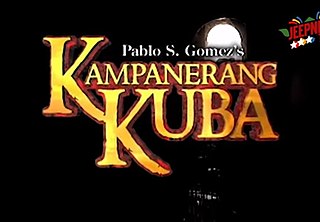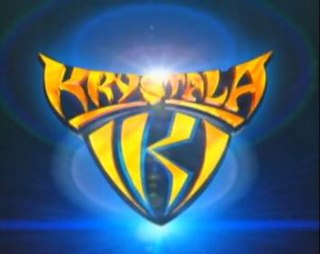Vandolph Lacsamana Quizon is a Filipino actor, comedian and politician. He also serves as a councilor of Parañaque from the 1st district since 2016.

Kampanerang Kuba is a 2005 Philippine fantasy soap opera television series broadcast by ABS-CBN. It aired from June 6 to December 16, 2005. It was inspired by the 1973 film of the same name, which starred Vilma Santos and Edgar Mortiz. It was tagged as Pinoy Disney. It was originally based from a comic book series written by Pablo S. Gomez.

Sheryn Mae Poncardas Regis is a Filipino pop singer-songwriter, host, entrepreneur and occasional actress. She rose to fame during the first season of the singing competition Search for the Star in a Million where she placed runner-up to Erik Santos in 2003.

Venancio Johnson Paras Jr., better known as Benjie Paras, is a Filipino actor, comedian, and a retired professional basketball player who played for Shell Turbo Chargers and San Miguel Beermen of the Philippine Basketball Association (PBA). He is the only PBA player to win both Rookie of the Year and Most Valuable Player honors, in a single season (1989). As its star center, Paras led the Shell Turbo Chargers to championship titles.
Jessica Anne Rodriguez Maitim, better known as Jean Garcia, is a Filipino television and film actress, who hails from Angeles City. She is best known for her role as Madam Claudia Buenavista in the original version of Pangako Sa 'Yo, Alvina Montenegro in Ina, Kasusuklaman Ba Kita? and Karina "Rina" Mercado in The Half Sisters.

Krystala is a Philippine fantasy/sci-fi/adventure/soap opera serial (superserye/fantaserye) from the Philippines, where it was produced by and aired on ABS-CBN from October 11, 2004 to April 22, 2005. The show also aired simultaneously on The Filipino Channel and on a one-week delay on International Channel in the United States.
Bianca Charlotte King-Wintle is a German-born Filipino-Canadian former actress best known for playing the role as Noemi Manansala in the thriller drama series Sinner or Saint (2011), as Aviona in the hit fantaseryeMulawin (2004), as well as her first lead prime time soap, Luna Blanca (2012), where in she played the title role of black-skinned Luna.

Kristine Hermosa Orille-Sotto, professionally known by her maiden name Kristine Hermosa, is a Filipina actress. She is known for her roles in Pangako Sa ’Yo (2000–2002), Sana'y Wala Nang Wakas (2003–2004), and Dahil May Isang Ikaw (2009–2010).

Claudine Margaret Castelo Barretto is a Filipino actress, singer, and entrepreneur.
Maria Lourdes Egger dela Cruz-Casareo, better known by her screen name Angelika Dela Cruz, is a Filipino actress and singer. She started her career in 1995, and has since appeared in television shows and movies. Originally with ABS-CBN from 1995 to 1999 and again from 2003 to 2007, she became a contract artist under GMA Network in 1999 until 2003, and again since 2007.
Philippine television drama, also known as teleserye, Filipino telenovelas or P-drama, is a form of melodramatic, serialized, televised fiction in the Philippines. Teleserye is derived from two Filipino words: "tele", short for "telebisyón" (television) and "sérye" (series).

Sineserye Presents is a Philippine primetime soap opera broadcast by ABS-CBN. It literally means a film serialized to a TV series which is the show's concept.

Prinsesa ng Banyera is a 2007 Philippine weekday daytime soap opera of ABS-CBN's Hapontastic afternoon block, from October 8, 2007 to May 23, 2008 which aired after Wowowee. It stars Kristine Hermosa and Angelika Dela Cruz with TJ Trinidad, Rafael Rosell and Ara Mina. It ruled the afternoon programming and was also shown worldwide through The Filipino Channel weekdays and its affiliate S+A, and Saturdays as a 5-episode marathon.

Maria Luisa Angela Martinez de Leon-Rivera, better known as Angelu de Leon, is a Filipino actress and politician.

Michael Paulo Lingbanan Avelino is a Filipino actor, singer, model and a movie producer. Regarded as the "Prince of Philippine Teleserye", he is best known in television series such as Walang Hanggan (2012), Bridges of Love (2015), The General's Daughter (2020) he made a breakthrough role as Gregorio del Pilar in the Philippine war epic Heneral Luna (2015), which he reprised in a titular role for its sequel, Goyo: Ang Batang Heneral (2018).
Timothy Mark Pimentel Eigenmann, better known by his stage name Sid Lucero, is a Filipino television and film actor and model. He won the 31st Gawad Urian Best Actor award for his role in Selda.

Mary Jane Santa Ana Guck, better known by her stage name Jaclyn Jose, is a Filipino cinema and television actress who has earned international critical acclaim. She is best known for her roles in the films Private Show, White Slavery, and Santa Juana.
Robert Riu Andrews, popularly known as Bobby Andrews, is a Filipino actor, TV host and former matinee idol. Starting out as a commercial model, he rose to fame when he teamed up with Angelu de Leon in the famous teen-oriented television show T.G.I.S. and its sequel Growing Up.

Darating ang Umaga is a Philippine drama made by ABS-CBN aired from March 3 to November 14, 2003 replacing Sa Dulo ng Walang Hanggan. Starring Vina Morales and Eula Valdez. It also starred Jodi Sta. Maria and Ian Veneracion, who 12 years later would team up in yet another primetime drama along with Patrick Garcia from Pangako Sa 'Yo. The drama series was also competing with Habang Kapiling Ka of the rival network GMA Network after it premiered in November four months earlier.











